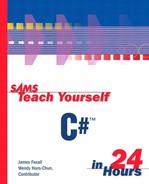Introduction
With Microsoft's introduction of the .NET platform, a new, exciting programming language was born. C# is the language of choice for developing on the .NET platform, and Microsoft has even written a majority of the .NET Framework using C#. C# is a modern object-oriented language designed and developed from the ground up with a best-of-breed mentality, implementing and expanding on the best features and functions found in other languages. C# combines the power and flexibility of C++ with the simplicity of Visual Basic.
Audience and Organization
This book is targeted toward those who have little or no programming experience. The book has been structured and written with a purpose, and that is to get you productive as quickly and as smoothly as possible. I've used my experiences from writing large commercial applications to create a book that, hopefully, cuts through the fluff and teaches you what you need to know. All too often, authors fall into the trap of focusing on the technology rather than on the practical application of the technology. I've worked hard to keep this book focused on teaching you practical skills that you can apply immediately toward a development project. Please feel free to send me your suggestions or success stories at [email protected].
This book is divided into five parts, each of which focuses on a different aspect of developing applications with C#. These parts generally follow the flow of tasks you'll perform as you begin creating your own programs using C#. I recommend that you read them in the order in which they appear.
Part I The Visual Studio Environment teaches you about the Visual Studio's C# development environment, including how to navigate and access 'numerous tools. In addition, you'll learn some key development concepts such as objects, collections, and events.
Part II Building a User Interface shows you how to build attractive and functional user interfaces. In this part, you'll learn about forms and controls—the user-interface elements such as text boxes and list boxes.
Part III Making Things Happen—Programming! teaches you the nuts and bolts of C# programming—and there's a lot to learn. You'll discover how to create methods, as well has how to store data, perform loops, and make decisions in code. After you've learned the core programming skills, you'll move into object-oriented programming and debugging applications.
Part IV Working with Data introduces you to working with a database and shows you how to automate external applications such as Word and Excel. In addition, this part teaches you how to manipulate a user's file system.
Part V Deploying Solutions and Beyond shows you how to distribute an application that you've created to an end user's computer. Then, the focus is brought back a bit to take a look at Web programming and Microsoft's .NET initiative from a higher, less-technical level.
Conventions Used in This Book
This book uses several conventions to help you prioritize and reference the information it contains:
Tips highlight information that can make your C# programming more effective.
Cautions focus your attention on problems or side effects that can occur in specific situations.
Notes provide useful sidebar information that you can read immediately or circle back to without losing the flow of the topic at hand.
New Term icons signal places where new terminology is first used and defined. Such terminology appears in an italic typeface for emphasis.
In addition, this book uses various typefaces to help you distinguish code from regular English. Code is presented in a monospace font. Placeholders—words or characters used temporarily to represent the real words or characters you would type in code—are typeset in italic monospace.
Some code statements presented in this book are too long to appear on a single line. In these cases, a line-continuation character (an underscore) is used to indicate that the following line is a continuation of the current statement.
Onward and Upward!
This is an exciting time to be learning how to program, and it's my sincerest wish that when you finish this book, you will feel capable of creating, debugging, and deploying modest C# programs using many C# and Visual Studio tools. Although you won't be an expert, you'll be surprised at how much you've learned. And hopefully, this book will help you determine your future direction as you proceed down the road to C# mastery.
